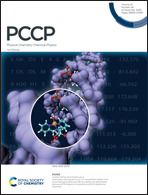Improvement of d–d interactions in density functional tight binding for transition metal ions with a ligand field model: assessment of a DFTB3+U model on nickel coordination compounds†
Abstract
To improve the description of interactions among the localized d, f electrons in transition metals, we have introduced a ligand-field motivated contribution into the Density Functional Tight Binding (DFTB) model. Referred to as DFTB3+U, the approach treats the d, f electron repulsions with rotationally invariant orbital–orbital interactions and a Hartree–Fock model; this represents a major conceptual improvement over the original DFTB3 approach, which treats the d, f-shell interactions in a highly averaged fashion without orbital level of description. The DFTB3+U approach is tested using a series of nickel compounds that feature Ni(II) and Ni(III) oxidation states. By using parameters developed with the original DFTB3 Hamiltonian and empirical +U parameters (F0/2/4 Slater integrals), we observe that the DFTB3+U model indeed provides substantial improvements over the original DFTB3 model for a number of properties of the nickel compounds, including the population and spin polarization of the d-shell, nature of the frontier orbitals, ligand field splitting and the energy different between low and high spin states at OPBE optimized structures. This proof-of-concept study suggests that with self-consistent parameterization of the electronic and +U parameters, the DFTB3+U model can develop into a promising model that can be used to efficiently study reactive events involving transition metals ion condensed phase systems. The methodology can be integrated with other approximate QM methods as well, such as the extended tight binding (xTB) approach.

- This article is part of the themed collection: Quantum Theory: The Challenge of Transition Metal Complexes


 Please wait while we load your content...
Please wait while we load your content...